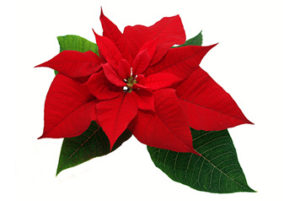
The poinsettia, part of the Spurge family, is known as Euphorbia pulcherrima, translated it means “very beautiful.” Many plants in the Euphorbiaceae family ooze milky sap.
It has a single female flower, without petals and usually without sepals, surrounded by individual male flowers enclosed in a cup-shaped structure, the cyathium. The showy red, pink, white, or bi-colored portion of the plant referred to as the flower, are modified leaves or bracts. Poinsettias are not poisonous.
The poinsettia is indigenous to Mexico and derives its common name from Joel Roberts Poinsett, the first United States Minister to Mexico, who introduced the plant to the US in 1825. Poinsett, a botanist, had some plants sent to his home in Greenville, South Carolina, where they did well in his greenhouse, and he distributed plants to botanical gardens and horticultural friends. In Mexico the poinsettia is a perennial shrub that will grow 10-15 feet tall.
The plant’s association with Christmas began in 16th-century Mexico. The legend tells of a girl, called Pepita or Maria, who was too poor to provide a gift for the Jesus’ birthday celebration. Inspired by an angel, she gathered weeds from the roadside and placed them in front of the church altar. Crimson blossoms sprouted from the weeds and became poinsettias. Since the 17th century Franciscan friars in Mexico have included them in Christmas celebrations. The star-shaped leaf symbolizes the Star of Bethlehem and the red color represents the blood of Jesus.
December 12th is Poinsettia Day, marking the death of Joel Roberts Poinsett in 1851.
The poinsettia was a symbol of purity to the Indians. The Aztecs used the plant to produce red dye and as a fever reducer. The plant is known in Mexico and Guatemala as “”La Flor de la Nochebuena” (Flower of the Holy Night).
The poinsettia is the most popular holiday flower and the number one flowering potted plant in the United States. For the longest-lasting poinsettias, choose plants with little or no yellow pollen showing. Poinsettias are not frost-tolerant but will grow outdoors in temperate coastal climates,
To prolong the life of this Christmas plant, avoid hot or cold drafts, keep the soil moist not soggy, and place in a room with sufficient natural light and temperatures around 60 to 70 degrees F. Water when soil begins to dry. Once leaves wilt too far, it’s too late. Poinsettias are highly sensitive to cold temperatures and a few minutes of exposure to 50-degree F or lower temperatures will cause them to wilt.
